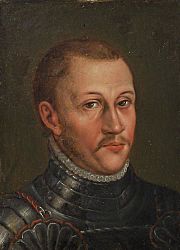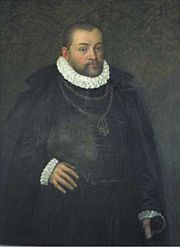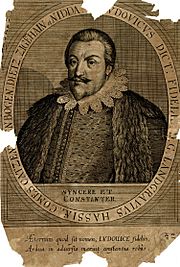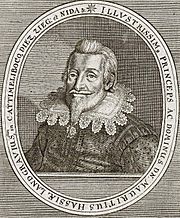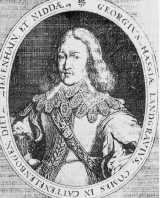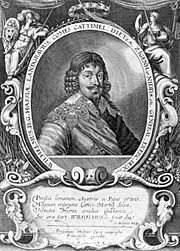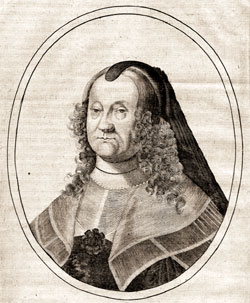Hessian War facts for kids
Quick facts for kids Hessian War |
|||||||
|---|---|---|---|---|---|---|---|
| Part of Thirty Years' War | |||||||
|
|||||||
| Belligerents | |||||||
| Commanders and leaders | |||||||
|
William IV (d 1592) Maurice (d 1632) William V (d 1637)Amalie Kaspar Kornelius Mortaigne de Potelles † Johann von Geyso |
George I (d 1596) Louis V (d 1626) George II Ernst Albrecht von Eberstein |
||||||
The Hessian War (also known as the Hessenkrieg in German) was a long conflict in Germany. It lasted from 1567 to 1648. This war was fought between different branches of the same princely family, the House of Hesse. The main groups fighting were the Landgraviate of Hesse-Cassel and the Landgraviate of Hesse-Darmstadt.
The war started because of a family inheritance dispute. When Philip I, the last ruler of all Hesse, died in 1567, he divided his land among his four sons. This division led to disagreements that grew into a long conflict. The fighting became very serious in the 1620s and peaked after 1645.
The main part of the war, called the Hessian War proper, began with the Siege of Marburg in 1645. It ended in April 1648 with Hesse-Cassel winning. After the war, the region of Upper Hesse was divided. Parts of its land went to the stronger Hesse-Cassel.
During the Thirty Years' War, Hesse-Cassel, which followed the Calvinist faith, joined forces with Protestant Sweden and Catholic France. Hesse-Darmstadt, even though it was Lutheran, sided with the Emperor. Soldiers from Hesse fought in many places, not just in Hesse.
This conflict is different from an earlier "Hessian War" in 1528. That one involved Landgrave Philip I against two prince-bishoprics.
Contents
Who Was Involved?
The Hessian War was a family feud over land. It started when Philip I, the ruler of all Hesse, died. He had four sons, and he divided his land among them. This led to four different parts of Hesse.
Here is a simple family tree showing the main rulers involved:
| Landgraviate of Hesse | |||||||||||||||||||||||||||||
| Philip I "The Magnanimous" (1504–1567) |
|||||||||||||||||||||||||||||
| Hesse-Cassel (North Hesse) = about 50% of the land |
Hesse-Marburg (Middle Hesse) = about 25% of the land |
Hesse-Rheinfels (Part of Rhineland-Palatinate) = about 15% of the land |
Hesse-Darmstadt (South Hesse) = about 10% of the land |
||||||||||||||||||||||||||
| William IV (1532–1592) |
Louis IV (1537–1604) †† Line ended |
Philip II (1541–1583) †† Line ended |
George I (1547–1596) |
||||||||||||||||||||||||||
| Maurice (1572–1632) gave up power 1627 |
Louis V (1577–1626) |
||||||||||||||||||||||||||||
| William V (1602–1637) married Amalie Elisabeth |
George II (1605–1661) |
||||||||||||||||||||||||||||
- Hesse-Cassel was the largest part. It was in the north.
- Hesse-Marburg was in the center.
- Hesse-Rheinfels was in the west. This family line died out in 1583. Its land was divided among the other three brothers.
- Hesse-Darmstadt was the smallest part, in the south.
The main conflict was between Hesse-Cassel and Hesse-Darmstadt.
How the War Unfolded
The Start of the Conflict
The war began because of Philip the Magnanimous's will. When he died in 1567, he wanted his land to be split among his four sons. This was according to an old family rule.
Here's how the land was divided:
- His oldest son, William, got the northern part. This became Hesse-Cassel. It included the city of Kassel and was about half of Hesse.
- His second son, Louis, received Upper Hesse in the center. This became Hesse-Marburg. It included Marburg and Giessen, about a quarter of Hesse.
- His third son, Philip (the Younger), got the western part. This became Hesse-Rheinfels. It included Rheinfels Castle, about one-eighth of Hesse. This family line ended in 1583.
- His youngest son, George, got the southern part. This became Hesse-Darmstadt. It included Darmstadt, less than one-eighth of Hesse.
When the Hesse-Rheinfels family line died out in 1583, its land was divided among the other three brothers.
The Marburg Inheritance Dispute
The Marburg Land Problem (from 1604)
In 1604, Louis IV died without children. In his will, he said Hesse-Marburg should be split equally between the sons of his late brothers, William (from Cassel) and George (from Darmstadt). But there was a condition: all of Hesse-Marburg had to remain Lutheran.
At first, there was a fight over how to split the land. Hesse-Darmstadt wanted it split by the number of nephews, which would give them more. But a high court, the Aulic Council, decided it should be split in half, favoring Hesse-Cassel.
In 1605, the dispute got worse. Landgrave Maurice of Hesse-Cassel changed his religion to Calvinism. He also made new Calvinist laws in his area. Many Lutheran priests then moved to Hesse-Darmstadt. The Lutheran teachers from the University of Marburg also moved to Giessen.
Because Maurice changed the religion of Hesse-Marburg, Hesse-Darmstadt argued he had broken Louis IV's will. They believed Maurice had lost his claim to the land. However, Darmstadt was not strong enough to fight for all of Hesse-Marburg at that time.
Hesse-Darmstadt Gains Power (1618–1627)
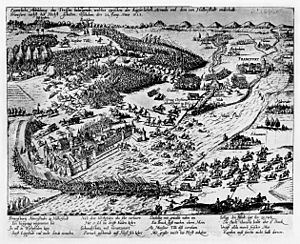
During the Thirty Years' War, Louis V of Hesse-Darmstadt tried to stay neutral at first. But he slowly sided with the Roman Catholic emperor. Meanwhile, Calvinist Hesse-Cassel joined the Protestant Union. When a Protestant duke invaded Upper Hesse in 1621, Louis V openly allied with the emperor. He hoped for military help.
This plan worked out for Darmstadt. In 1621, an imperial general occupied the Wetterau region. In response, a Protestant army leader captured Louis V and his son. To get them back, Louis V had to give up the Rüsselsheim fortress.
Later, the Protestant army was defeated in the Battle of Höchst in 1622. This weakened the Protestant side. Imperial forces then occupied Lower Hesse, including Kassel. They enforced the court's decision from 1623. This ruling gave all of Hesse-Marburg, including its past tax money, to Hesse-Darmstadt.
Because of military losses and poor leadership, Landgrave Maurice of Hesse-Cassel was forced to give up his power in 1627. His son, William V, had to accept the court's decision. On September 24, 1627, a peace agreement was made. It was called the Hauptakkord. All of Upper Hesse, the Lower County of Katzenelnbogen, and the Barony of Schmalkalden went to Hesse-Darmstadt. In return, Hesse-Cassel got back some lands that had been held as security.
Hesse-Cassel's Comeback (1630–1634)
After the peace agreement, William V secretly started building a new army. A big change for Hesse-Cassel came in October 1630. William V was the first German Protestant prince to ally with King Gustavus II Adolphus of Sweden. This alliance was made official in 1631. Hesse-Cassel's army then fought for the Swedish king. In return, Sweden promised Hesse-Cassel more land if they won.
With Sweden's help, Hesse-Cassel's troops had many successes. They drove the imperial forces out of Hesse-Cassel. They captured Hersfeld and Fritzlar. The imperial troops were weakened after their defeat in the Battle of Breitenfeld.
Hesse-Cassel hoped to get back its lost lands in Upper Hesse. But George II of Hesse-Darmstadt made a deal with the Swedish king. In 1631, Darmstadt's neutrality was recognized. This meant Darmstadt kept its lands in Upper Hesse. Instead, Hesse-Cassel was given other areas outside Hesse that its troops had conquered.
Imperial Forces Attack Hesse-Cassel (from 1634)
After the Battle of Lützen in 1632, where the Swedish-Protestant side lost their king, the war turned against the Protestants. After their defeat in the Battle of Nördlingen in 1634, the Protestant alliance fell apart. Hesse-Cassel could not agree to the Treaty of Prague in 1635. This was because Darmstadt demanded too much, wanting to take over all of Hesse-Cassel. So, Hesse-Cassel continued fighting with Sweden and France against the Emperor. Hesse-Darmstadt, on the other hand, openly fought for the Emperor.
Both sides had some wins. Darmstadt gained some new territories. Hesse-Cassel won a victory at Hanau in 1636. But neither side won a decisive victory.
Because of his alliance with France, William V of Hesse-Cassel was declared an "outlaw" in 1636. His enemy from Darmstadt was made the ruler of all Hesse. But this ban did not work because of the ongoing fighting.
The war had lasted over two decades, and Hesse was suffering greatly. In 1637, the local leaders from all parts of Hesse tried to arrange a peace meeting. But this meeting failed. The Emperor sent troops to enforce the ban against William V. These troops destroyed much of Lower Hesse. William V fled with his family and army to East Frisia, where he died from illness in 1637.
Hesse-Cassel's Return to Power (from 1637)
William V's son, William VI, was only eight years old when his father died. So, William V's wife, Amalie Elisabeth, became the guardian and ruler of Hesse-Cassel. She was a very smart leader. She managed to make Hesse-Cassel strong again, even though it was a very difficult time.
First, she made a fake truce with the Emperor. This stopped Kassel from being conquered. Then, she rebuilt a strong army. In 1639, she made an alliance with France and Sweden.
With her new allies, Amalie Elisabeth's troops moved against the Electorate of Cologne. They wanted to defend the lands they had already conquered. In 1641, Hesse-Cassel lost the town of Dorsten after a long siege. But after the imperial forces left to fight elsewhere, Hesse-Cassel launched another campaign. They won a big victory at the Battle of Kempen. This led to Hesse-Cassel occupying large areas in the north.
The Final Years of the Hessian War (1645–1648)
By 1644, Landgravine Amalia Elisabeth felt strong enough to fight for the Marburg inheritance again. She had the 1627 peace treaty, which had taken Upper Hesse from Cassel, declared invalid. In late 1645, she sent her experienced troops towards Marburg. After a short siege, Marburg and Butzbach surrendered. Most of Upper Hesse came under Kassel's rule again in early 1646.
In 1647, an imperial army managed to take back the town of Marburg, but not its castle. However, Darmstadt and the Upper County were then attacked by French troops. So, this success for the imperial side did not last long. By the end of 1647, Kassel's troops had re-occupied most of Lower and Upper Hesse. In early 1648, the imperial troops left Marburg.
The Hessian War was finally settled through talks. These talks happened at the same time as the larger Westphalian Peace Congress. A peace treaty between Cassel and Darmstadt was signed in April 1648, before the main Treaty of Westphalia. Just before this, Cassel fought one last battle against the imperial side, winning the Battle of Wevelinghoven.
Under the new peace treaty between Cassel and Darmstadt, Upper Hesse was permanently divided. Darmstadt had to give up a large part of Upper Hesse to Cassel. This included Marburg and other lands, like the Lower County of Katzenelnbogen and the Barony of Schmalkalden.
Images for kids
-
Battle of Höchst (1622)


